Military Justice System Statistics
The Office of the JAG is committed to collecting the most accurate quantitative data available on the military justice system. The 2024/2025 reporting period marks the first time since the summary hearing system was introduced in June 2022 that enough data exists to support a meaningful year-over-year comparison.Footnote 74
Summary Hearings
During this reporting period, 518 summary hearings were conducted. This represents close to a 15% increase over the number of summary hearings conducted during the previous reporting period and an even larger increase over the number of summary trials conducted during the 2021/2022 and the 2022/2023 reporting periods (the last two reporting periods when the summary trial procedure was in use). The increased use of summary hearings suggests that the summary hearing process is being readily adopted at the unit level as a fast and flexible tool for addressing minor misconduct. Having said that, it is also worth noting that the number of summary hearings remains below the number of summary trials in the 2018/2019 reporting period, the last full reporting period before the imposition of COVID 19 restrictions that generally reduced the number of disciplinary proceedings. Figure 3.1 shows the number of summary hearings and courts martial held over the reporting period compared with the last one. Figure 3.2 shows the number of summary hearings or summary trials held each reporting period since 2018/2019.
Figure 3.1: Distribution of Proceedings

Graph breakdown — Figure 3.1: Distribution of Proceedings
| - | 2023/24 | 2024/25 |
|---|---|---|
| Summary Hearings | 441 | 518 |
| Courts Martial | 46 | 32 |
Figure 3.2: Summary Procedures for the Past Seven Reporting Periods

Graph breakdown — Figure 3.2: Summary Procedures for the Past Seven Reporting Periods
| - | 2018/19 | 2019/20 | 2020/21 | 2021/22 | 2022/23 | 2023/24 | 2024/25 |
|---|---|---|---|---|---|---|---|
| Summary Trials | 595 | 513 | 336 | 398 | 96 | — | — |
| Summary Hearings | — | — | — | — | 253 | 441 | 518 |
Summary Hearings by Organization
In 2024/2025, eight organizations were responsible for nearly 99% of the summary hearings. Figure 3.3 shows the total number of summary hearings held over the reporting period within these organizations (Canadian Army (CA), Royal Canadian Navy (RCN), Royal Canadian Air Force (RCAF), Military Personnel Command (MilPersCom), Canadian Joint Operations Command (CJOC), Canadian Special Operations Forces Command (CANSOFCOM), Vice Chief of Defence Staff (VCDS), Canadian Forces Intelligence Command (CFINTCOM)) as well as the combined number for all other organizations. The distribution of summary hearings across organizations, with the CA accounting for the highest number of hearings (209 or 40.3%) followed by the RCN (130 or 25.09%), aligns with the distribution of summary proceedings in previous reporting periods back to 2018/2019, including reporting periods when the summary trial procedure was still in use.
Figure 3.3: Summary Hearings by Organization
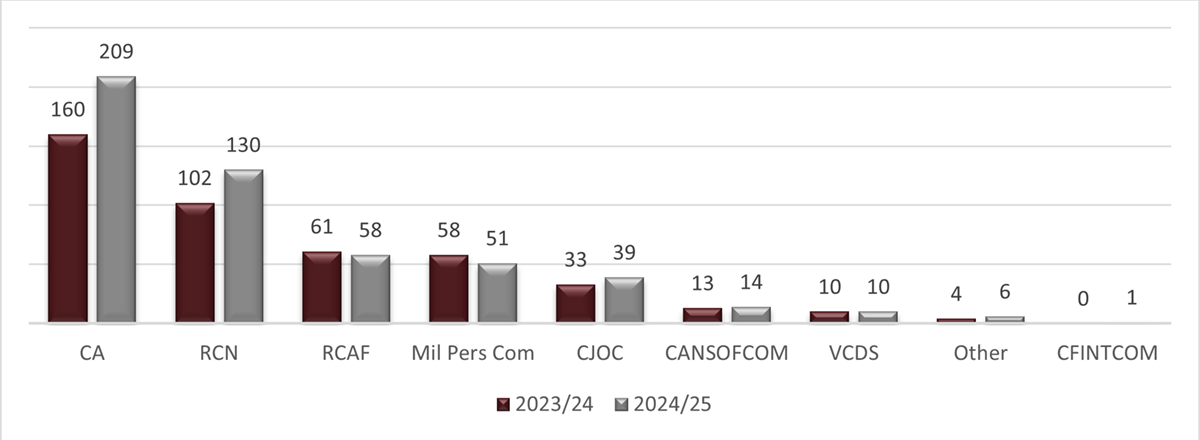
Graph breakdown — Figure 3.3: Summary Hearings by Organization
| - | 2023/24 | 2024/25 |
|---|---|---|
| Canadian Army | 160 | 209 |
| Royal Canadian Navy | 102 | 130 |
| Royal Canadian Air Force | 61 | 58 |
| Military Personnel Command | 58 | 51 |
| Canada Joint Operations Command | 33 | 39 |
| Canada Special Operations Forces Command | 13 | 14 |
| Vice Chief of Defence Staff | 10 | 10 |
| Other | 4 | 6 |
| Canadian Forces Intelligence Command | 0 | 1 |
Charges Disposed of at Summary Hearing
During this reporting period, 903 charges for service infractions were disposed of at summary hearing. There were 823 charges disposed of at summary hearing for infractions in relation to military service under article 120.03 of the Queen’s Regulations and Orders for the Canadian Forces, accounting for over 91% of the total number of charges. There were 46 charges disposed of for service infractions in relation to drugs and alcohol under article 120.04, accounting for approximately 5% of the total and 34 charges disposed of for service infractions in relation to property and information under article 120.02, accounting for nearly 4% of the total. Figure 3.4 provides the number of charges for each category of service infraction disposed of at summary hearing during the 2023/2024 and 2024/2025 reporting periods. A more detailed list of each infraction disposed of at summary hearing in the last two reporting periods is provided at Annex A.
Figure 3.4: Charges Disposed of at Summary Hearing

Graph breakdown — Figure 3.4: Charges Disposed of at Summary Hearing
| 2023/24 | 2024/25 | |
|---|---|---|
| 120.02 - INFRACTIONS IN RELATION TO PROPERTY AND INFORMATION | 21 | 34 |
| 120.03 - INFRACTIONS IN RELATION TO MILITARY SERVICE | 601 | 823 |
| 120.04 - INFRACTIONS IN RELATION TO DRUGS AND ALCOHOL | 47 | 46 |
Figure 3.5 sets out the breakdown of the charges disposed of at summary hearing for infractions in relation to property and information under article 120.02 during the 2023/2024 and 2024/2025 reporting periods.
Figure 3.5: Charges Disposed of under QR&O 120.02 (Infractions in Relation to Property and Information)
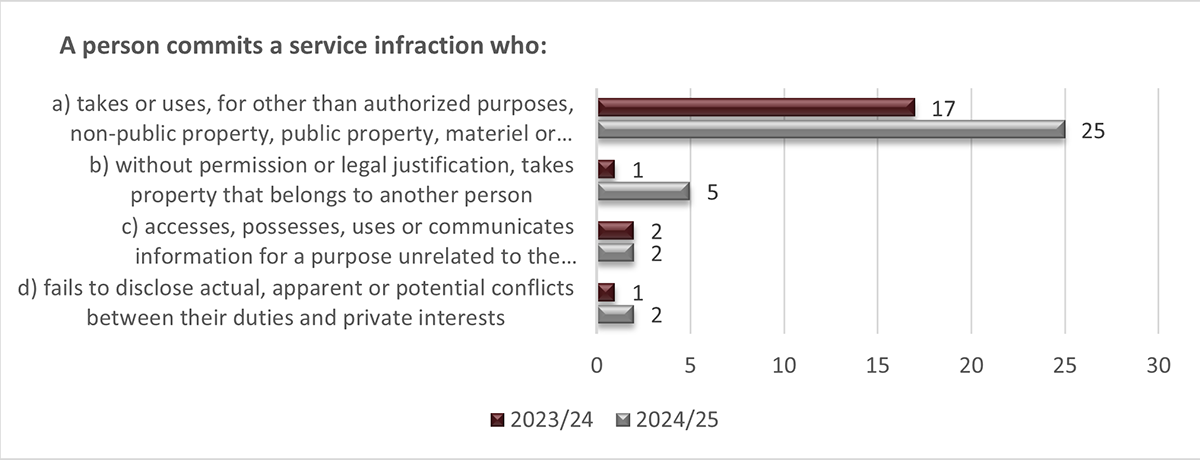
Graph breakdown — Figure 3.5: Charges Disposed of under QR&O 120.02 (Infractions in Relation to Property and Information)
| A person commits a service infraction who: | 2023/24 | 2024/25 |
|---|---|---|
| a) takes or uses, for other than authorized purposes, non-public property, public property, materiel or government-issued property or damages that property or materiel | 17 | 25 |
| b) without permission or legal justification, takes property that belongs to another person | 1 | 5 |
| c) accesses, possesses, uses or communicates information for a purpose unrelated to the performance of their duties | 2 | 2 |
| d) fails to disclose actual, apparent or potential conflicts between their duties and private interests | 1 | 2 |
Of the 34 charges disposed of for infractions in relation to property and information under article 120.02, by far the most common was paragraph 120.02(a) (takes or uses, for other than authorized purposes, non-public property, public property, materiel or government-issued property or damages that property or materiel), which accounted for over 73% of all charges under article 120.02. As a percentage of charges, this is a decrease from the previous reporting period, though in terms of the number of charges, it marks a small increase.
Of the three categories of service infractions, the most frequently charged was service infractions in relation to military service, under article 120.03 of the Queen’s Regulations and Orders for the Canadian Forces. Article 120.03 includes nine individual service infractions, the highest number of the three categories. It also includes the two most common infractions disposed of at summary hearing: paragraph 120.03(f) (without reasonable excuse, fails to attend or is tardy to their place of duty) and paragraph 120.03(i) (behaves in a manner that adversely affects the discipline, efficiency, or morale of the Canadian Forces). These two infractions apply to misconduct that previously would have been dealt with under the summary trial system as the service offences of Absence without Leave and Conduct to the Prejudice of Good Order and Discipline (sections 90 and 129 of the National Defence Act, respectively). The number of charges for these infractions during the past two reporting periods are broadly similar to the number of charges that had been laid for the analogous service offences in previous reporting periods when the summary trial procedure was in use. Figure 3.6 sets out the breakdown of the charges disposed of at summary hearing for infractions in relation to military service under article 120.03 of the Queen’s Regulations and Orders for the Canadian Forces during the 2023/2024 and 2024/2025 reporting periods. Figures 3.7 and 3.8 show the comparison between the number of charges under paragraphs 120.03(f) and 120.03(i) of the Queen’s Regulations and Orders for the Canadian Forces and sections 90 and 129 of the National Defence Act, respectively, from the 2018/2019 reporting period until the present one.
Figure 3.6: Charges Disposed of under QR&O 120.03 (Infractions in Relation to Military Service)

Graph breakdown — Figure 3.6: Charges Disposed of under QR&O 120.03 (Infractions in Relation to Military Service)
| A person commits a service infraction who: | 2023/24 | 2024/25 |
|---|---|---|
| (a) handles a weapon, explosive substance, or ammunition in a dangerous manner | 9 | 8 |
| (b) discharges a firearm without authorization | 27 | 42 |
| (c) behaves in a manner that could reasonably undermine the authority of a superior officer | 26 | 47 |
| (d) fails or while on duty is unfit to effectively perform their duties or carry out responsibilities | 33 | 42 |
| (e) in relation to military service, furnishes false or misleading information, or engages in deceitful conduct | 39 | 57 |
| (f) without reasonable excuse, fails to attend or is tardy to their place of duty | 189 | 223 |
| (g) dresses in a manner or adopts an appearance or demeanour that is inconsistent with Canadian Forces requirements | 15 | 71 |
| (h) fails to maintain personal equipment or assigned quarters in accordance with Canadian Forces requirements | 6 | 13 |
| (i) otherwise behaves in a manner that adversely affects the discipline, efficiency, or morale of the Canadian Forces | 257 | 320 |
Figure 3.7: Comparisons of National Defence Act s.90 and QR&O 120.03(f)

Graph breakdown — Figure 3.7: Comparisons of National Defence Act s.90 and QR&O 120.03(f)
| - | 2018/19 | 2019/20 | 2020/21 | 2021/22 | 2022/23 | 2023/24 | 2024/25 |
|---|---|---|---|---|---|---|---|
| NDA s.90 - Absence without Leave | 298 | 269 | 153 | 147 | 35 | — | — |
| QR&O 120.03(f) - A person commits a service infraction who without reasonable excuse, fails to attend or is tardy to their place of duty | — | — | — | — | 85 | 189 | 223 |
Figure 3.8: Comparisons of National Defence Act s.129 and QR&O 120.03(i)
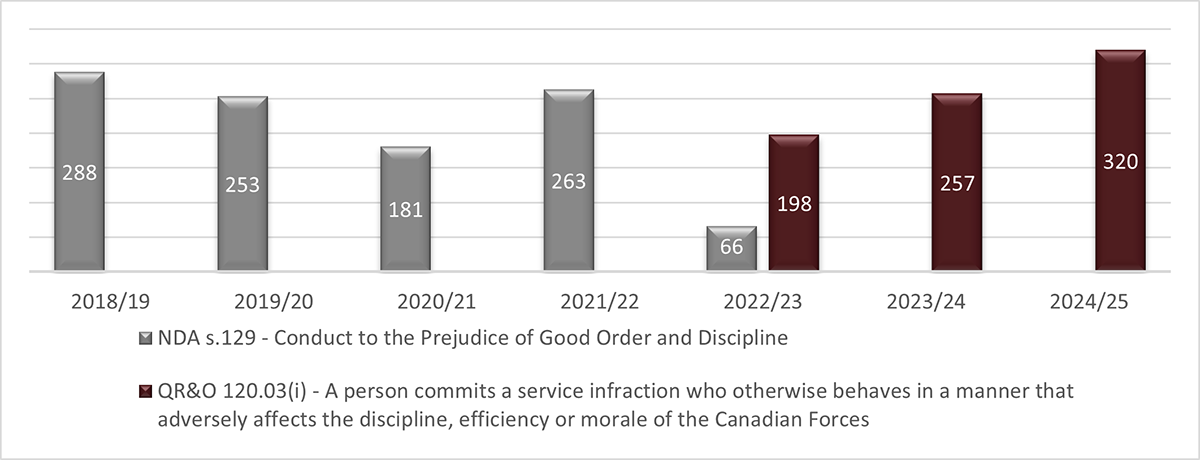
Graph breakdown — Figure 3.8: Comparisons of National Defence Act s.129 and QR&O 120.03(i)
| 2018/19 | 2019/20 | 2020/21 | 2021/22 | 2022/23 | 2023/24 | 2024/25 | |
|---|---|---|---|---|---|---|---|
| NDA s.129 - Conduct to the Prejudice of Good Order and Discipline | 288 | 253 | 181 | 263 | 66 | — | — |
| QR&O 120.03(i) - A person commits a service infraction who otherwise behaves in a manner that adversely affects the discipline, efficiency or morale of the Canadian Forces | — | — | — | — | 198 | 257 | 320 |
The total number of charges disposed of during this reporting period for infractions in relation to drugs and alcohol under article 120.04 of the Queen’s Regulations and Orders for the Canadian Forces is very close to the number of charges disposed of during the previous reporting period (46 and 47, respectively) as is their distribution. The most commonly charged infraction under this article was paragraph 120.04(c) (introduces, possesses or consumes an intoxicant contrary to article 19.04 of the Queen’s Regulations and Orders for the Canadian Forces (Intoxicants)), accounting for nearly 48% of all charges under this article. Figure 3.9 sets out the breakdown of the charges disposed of at summary hearing for infractions in relation to drugs and alcohol under article 120.04 of the Queen’s Regulations and Orders for the Canadian Forces during the 2023/2024 and 2024/2025 reporting periods.
Figure 3.9: Charges Disposed of under QR&O 120.04 (Infractions in Relation to Drugs and Alcohol)

Graph breakdown — Figure 3.9: Charges Disposed of under QR&O 120.04 (Infractions in Relation to Drugs and Alcohol)
| - | 2023/24 | 2024/25 |
|---|---|---|
| (a) while on duty, is impaired by a drug or alcohol | 13 | 15 |
| (b) uses a drug contrary to article 20.04 (Prohibition) | 11 | 9 |
| (c) introduces, possesses or consumes an intoxicant contrary to article 19.04 (Intoxicants) | 23 | 22 |
Findings at Summary Hearing
During the reporting period, 794 charges resulted in a finding that the alleged service infraction was committed, representing approximately 88% of charges. 87 charges resulted in a finding that the alleged service infraction was not committed, representing nearly 10% of charges. 22 charges were not proceeded with at summary hearing. These percentages are similar to the 2023/2024 reporting period, when 89% of charges resulted in a finding that the service infraction had been committed, and 9% of charges resulted in a finding that the infraction had not been committed. The statistics for findings at summary hearing for both the 2023/2024 and the present reporting period are set out at Figure 3.10.
Figure 3.10: Findings at Summary Hearing
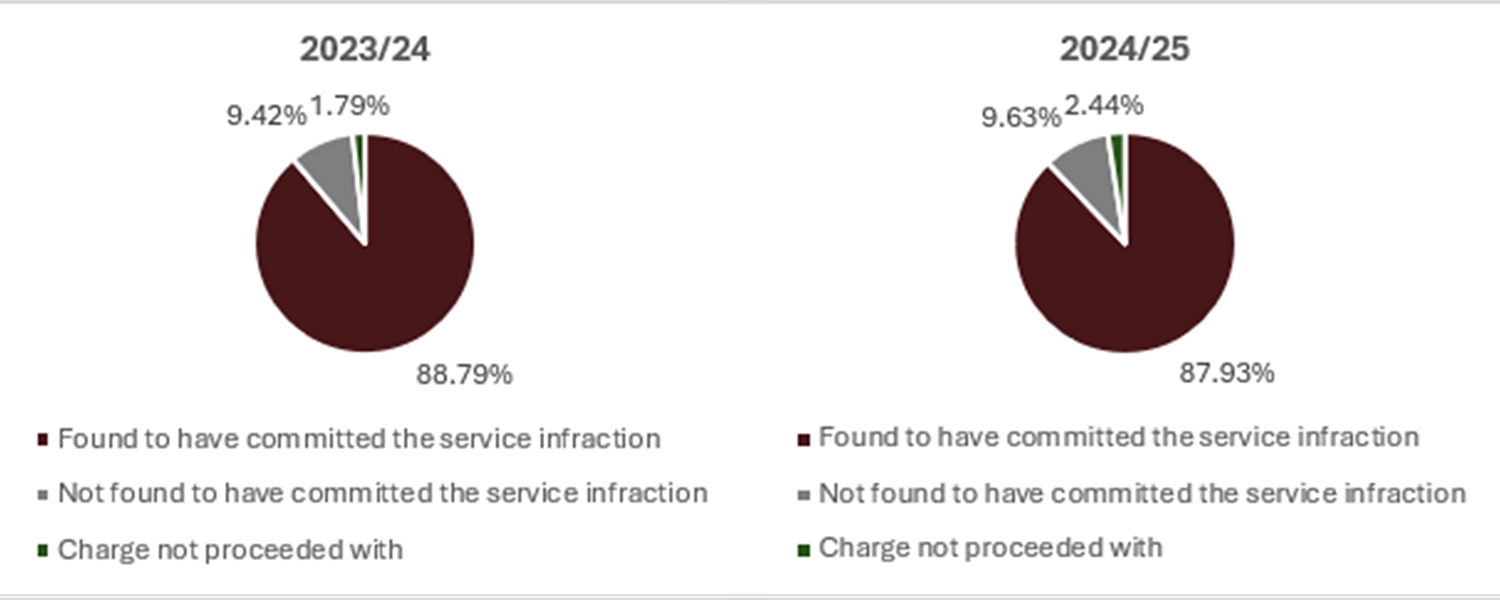
Graph breakdown — Figure 3.10: Findings at Summary Hearing
| - | 2023/24 | 2024/25 |
|---|---|---|
| Found to have committed a service infraction | 88.79% | 87.93% |
| Not found to have committed a service infraction | 9.42% | 9.63% |
| Charge not proceeded with | 1.79% | 2.44% |
Sanctions at Summary Hearing
OCSHs are limited in the types of sanctions they may impose on a member found to have committed a service infraction. Arranged from the most severe to the least severe, the available sanctions are: reduction in rank, severe reprimand, reprimand, deprivation of pay and allowances for no more than 18 days, and minor sanctions, which include confinement to ship or barracks for no more than 14 days, extra work and drill for no more than 14 days, and the withholding of leave for no more than 30 days. Reflecting the non-penal nature of the summary hearing system, OCSHs do not have authority to impose detention as a sanction.
Deprivation of pay was the most common sanction imposed at summary hearing during this reporting period, accounting for over 38% of sanctions. This is similar to the 2023/2024 reporting period when it accounted for over 47% of sanctions. Extra work and drill was the second most frequently imposed sanction, accounting for over 31% of sanctions, while confinement to ship or barracks accounted for over 20% of sanctions imposed. During the previous reporting period, extra work and drill accounted for over 25% of sanctions imposed, while confinement to ship or barracks accounted for nearly 20%. Figure 3.11 shows the relative number of each type of sanction that was imposed at summary hearing during the 2023/2024 and 2024/2025 reporting periods.
As reported in the 2023/2024 annual report, the processing of the sanction of deprivation of pay was placed on hold in the Canadian Armed Forces pay system by the Director of Human Resources and Business Management and the Director of Military Pay and Allowances Processing in the summer of 2023. The processing hold was put in place to ensure that a uniform method of administering the sanction was being used at the unit level. During this reporting period, key organizations continued to collaborate on the development of the policy required to implement the sanction. At the time of writing this report, the Chief of the Defence Staff had issued a direction on that matter, and the processing hold had already been lifted. Work continues on the correction of cases where this sanction was implemented incorrectly.
Figure 3.11: Sanctions at Summary Hearing
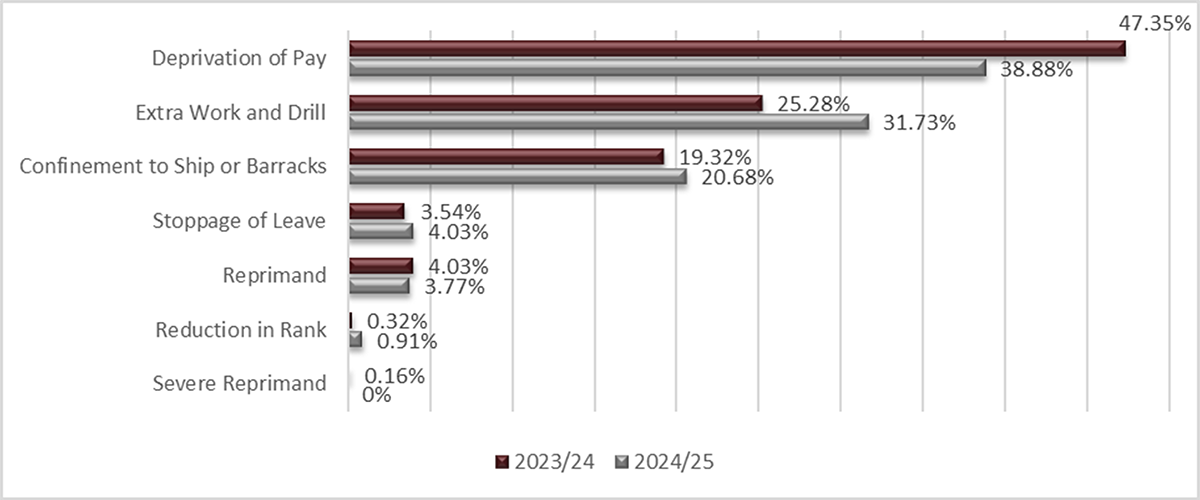
Graph breakdown — Figure 3.11: Sanctions at Summary Hearing
| - | 2023/24 | 2024/25 |
|---|---|---|
| Deprivation of Pay | 47.35% | 38.88% |
| Extra Work and Drill | 25.28% | 31.73% |
| Confinement to Ship or Barracks | 19.32% | 20.68% |
| Stoppage of Leave | 3.54% | 4.03% |
| Reprimand | 4.03% | 3.77% |
| Reduction in Rank | 0.32% | 0.91% |
| Severe Reprimand | 0.16% | 0% |
Summary Hearings by Rank
Jurisdiction of the summary hearing system over members of the Canadian Armed Forces is not dependent on rank. During the reporting period, there were a total of 366 summary hearings for junior non-commissioned members (between Private (Basic)/Sailor 3rd Class and Master Corporal/Master Sailor) and 75 for senior non-commissioned members (between Sergeant/Petty Officer 2nd Class and Chief Warrant Officer/Chief Petty Officer 1st Class). For officers, there were 19 summary hearings for subordinate officers (officer cadets/naval cadets), 54 hearings for junior officers (between Second Lieutenant/Acting Sub-Lieutenant and Captain/Lieutenant (Navy)), and four hearings for senior officers (Major/Lieutenant Commander and above). There were no summary hearings for any officers above the rank of Major/Lieutenant Commander. Figure 3.12 sets out the number and percentage of summary hearings organized by the rank of the person alleged to have committed the service infraction.
Figure 3.12: Summary Hearings by Rank
| 2023/24 | 2024/25 | |||
|---|---|---|---|---|
| # | % | # | % | |
| Private (Basic) / Sailor 3rd Class | 41 | 9.30 | 49 | 9.46 |
| Private / Aviator / Sailor 2nd Class | 67 | 15.19 | 82 | 15.83 |
| Corporal / Sailor 1st Class | 152 | 34.47 | 170 | 32.82 |
| Master Corporal / Master Sailor | 45 | 10.20 | 65 | 12.55 |
| Sergeant / Petty Officer 2nd Class | 41 | 9.30 | 47 | 9.07 |
| Warrant Officer / Petty Officer 1st Class | 20 | 4.54 | 22 | 4.25 |
| Master Warrant Officer / Chief Petty Officer 2nd Class | 9 | 2.04 | 6 | 1.16 |
| Chief Warrant Officer / Chief Petty Officer 1st Class | 2 | 0.45 | 0 | 0 |
| Officer Cadet / Naval Cadet | 17 | 3.85 | 19 | 3.67 |
| Second Lieutenant / Acting Sub-Lieutenant | 14 | 3.17 | 7 | 1.35 |
| Lieutenant / Sub-Lieutenant | 7 | 1.59 | 12 | 2.32 |
| Captain / Lieutenant (Navy) | 22 | 4.99 | 35 | 6.75 |
| Major / Lieutenant-Commander | 4 | 0.91 | 4 | 0.77 |
| Total | 441 | 100.00 | 518 | 100.00 |
Timeline for Summary Hearings
An essential feature of the summary hearing system is that they are required to commence within six months of the alleged commission of the service infraction. Summary hearings are intended to allow Canadian Armed Forces units to address misconduct as promptly as possible, while still maintaining a fair process. Delays in addressing disciplinary issues allow problems to persist and adversely impact a unit’s morale and efficiency. In this regard, the summary hearing system appears to be functioning as intended. The average number of days between an alleged infraction and the conclusion of the summary hearing during the reporting period was 81 days. These numbers suggest that the summary hearing process was more efficient during this reporting period than in 2023/2024, when the average number of days between an alleged infraction and the conclusion of the summary hearing during the reporting period was 93.5 days. Statistics for other stages of the summary hearing process also show signs that the system is becoming more efficient and timelier as familiarity with the system grows. In the previous reporting period, there was an average of 65 days between the commission of an alleged service infraction and the laying of charges, and approximately 28 days between the laying of charges and commencement of a summary hearing. In the current reporting period, the number of days had been reduced to 56 days and 27 days, respectively.
Figure 3.13 shows the percentage of cases completed within each tier of elapsed days between the date of an alleged service infraction and the completion of a summary hearing during the 2023/2024 and 2024/2025 reporting periods.
Figure 3.13: Elapsed Days between Alleged Service Infraction and Completion of Summary Hearing by Percentage of Cases
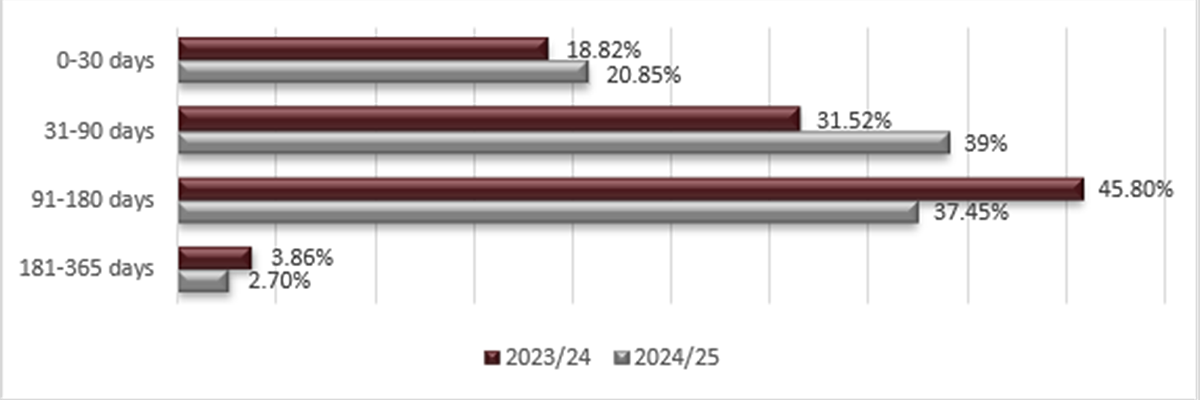
Graph breakdown — Figure 3.13: Elapsed Days between Alleged Service Infraction and Completion of Summary Hearing by Percentage of Cases
| - | 2023/24 | 2024/25 |
|---|---|---|
| 0-30 days | 18.82% | 20.85% |
| 30-90 days | 31.52% | 39% |
| 91-180 days | 45.80% | 37.45% |
| 181-365 days | 3.86% | 2.70% |
Reviews of Summary Hearings
The review of a summary hearing can be initiated at the request of the member who was found to have committed a service infraction or on the initiative of a review authority. During the 2024/2025 reporting period, there were 16 reviews, representing approximately 3% of summary hearings. These numbers are lower than for the 2023/2024 reporting period, when there were 26 reviews, representing approximately 5% of summary hearings.
Review authorities for summary hearings can uphold the finding that the member committed the service infraction, quash the finding, or substitute a finding. During this reporting period, review authorities upheld 12 findings, quashed one finding, and did not substitute any findings. With respect to sanctions imposed at summary hearing, review authorities substituted one sanction, commuted one sanction and mitigated one sanction. A breakdown of all decisions by review authorities for the 2023/2024 and 2024/2025 reporting periods may be found at Figure 3.14.
Figure 3.14: Decisions of Review Authorities

Graph breakdown —Figure 3.14: Decisions of Review Authorities
| - | 2023/24 | 2024/25 |
|---|---|---|
| Upholds Findings* | 15 | 12 |
| Quashes Findings | 4 | 1 |
| Substitutes Findings | 1 | 0 |
| Mitigates Sanction | 3 | 1 |
| Substitutes Sanction | 3 | 1 |
| Commutes Sanction | 0 | 1 |
*In one case during the 2023/2024 reporting period, the review authority made multiple decisions.
Language of Summary Hearings
Persons charged with having committed a service infraction have the right for the hearing to be conducted in the official language of their choice. An OCSH must be able to understand the language in which a summary hearing is to be conducted without the assistance of an interpreter.
In this reporting period, 418 summary hearings were conducted in English, and 100 summary hearings were conducted in French. These numbers are broadly consistent both with the previous reporting period and the proportion of anglophones to francophones in the Canadian Armed Forces (77% and 23%, respectively). Figure 3.15 shows the total number of summary hearings conducted in English and French for the 2023/2024 and 2024/2025 reporting periods.
Figure 3.15: Language at Summary Hearing

Graph breakdown — Figure 3.15: Language at Summary Hearing
| - | 2023/24 | 2024/25 |
|---|---|---|
| English | 376 | 418 |
| French | 65 | 100 |
Courts Martial
Referrals to the Director of Military Prosecutions
Since the coming into force of Bill C-77 in June 2022, all service offences are referred directly to the Director of Military Prosecutions. During this reporting period, the Director of Military Prosecutions received a total of 26 new referrals or requests for charges to proceed to trial by court martial, a decrease of 20 cases from the 2023/2024 reporting period. This number does not include referrals carried over from the previous reporting period. Figure 3.16 shows the number of referrals received by the Director of Military Prosecutions over the last five reporting periods.
Figure 3.16: Referrals to the Director of Military Prosecutions

Graph breakdown — Figure 3.12: Referrals to the Director of Military Prosecutions
| - | 2020/21 | 2021/22 | 2022/23 | 2023/24 | 2024/25 |
|---|---|---|---|---|---|
| Referrals to the DMP | 76 | 91 | 60 | 46 | 26 |
Charges Preferred by the Director of Military Prosecutions
During this reporting period, the Director of Military Prosecutions proceeded with charges or preferred charges in 25 cases for trial by court martial. There were two cases where the Director of Military Prosecutions did not proceed with or prefer any charges. Figure 3.17 illustrates the number of cases preferred by the Director of Military Prosecutions and the number of files where no charges were preferred over the past two reporting periods.
Figure 3.17: Cases Preferred by the Director of Military Prosecutions
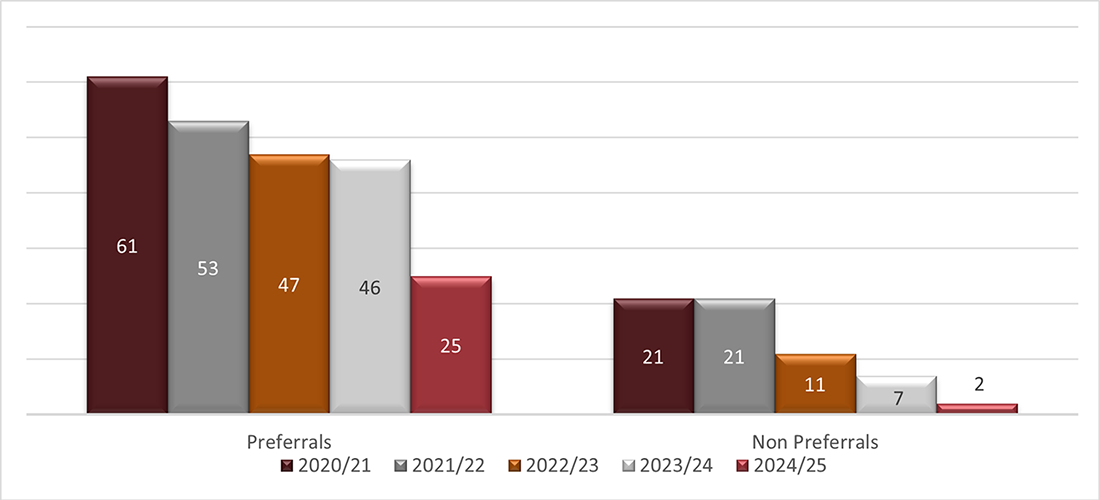
Graph breakdown — Figure 3.17: Cases Preferred by the Director of Military Prosecutions
| - | 2020/21 | 2021/22 | 2022/23 | 2023/24 | 2024/25 |
|---|---|---|---|---|---|
| Preferrals | 61 | 53 | 47 | 46 | 25 |
| Non Preferrals | 21 | 21 | 11 | 7 | 2 |
Number of Courts Martial
During this reporting period, 32 courts martial were conducted, a decrease from the 46 courts martial held during the previous reporting period. Of the 32 courts martial, nine involved contested trials, 19 were guilty pleas with joint submissions on sentencing, and four were guilty pleas where the sentence was contested. The most common service offence disposed of at court martial during this reporting period was conducted to the prejudice of good order and discipline under section 129 of the National Defence Act, which accounted for over 19.72% of offences. This is an increase from the previous reporting period when conduct to the prejudice of good order and discipline charges accounted for 14% of service offences. Figure 3.18 sets out the number of courts martial for the past five reporting periods. Annex B contains a summary of all service offences disposed of at court martial in the last two reporting periods.
Figure 3.18: Number of Courts Martial

Graph breakdown — Figure 3.18: Number of Courts Martial
| - | 2020/21 | 2021/22 | 2022/23 | 2023/24 | 2024/25 |
|---|---|---|---|---|---|
| General Courts Martial | 7 | 12 | 11 | 8 | 5 |
| Standing Courts Martial | 27 | 36 | 30 | 38 | 27 |
Dispositions of Cases at Court Martial
Of the 32 completed courts martial during this reporting period, 25 resulted in a finding of guilty on at least one charge, four resulted in a finding of not guilty on all charges or a stay of proceedings, and in three cases the accused was found guilty of a less serious offence. Figure 3.19 shows the disposition of cases over the past two reporting periods.
Figure 3.19: Disposition of Cases at Court Martial

Graph breakdown — Figure 3.19: Disposition of Cases at Court Martial
| - | 2020/21 | 2021/22 | 2022/23 | 2023/24 | 2024/25 |
|---|---|---|---|---|---|
| Found Guilty of at Least One Charge | 25 | 33 | 32 | 35 | 25 |
| Found Guilty of a Less Serious Offence | 1 | 3 | |||
| Not Guilty of All Charges or Stay of Proceedings | 7 | 14 | 9 | 9 | 4 |
| Not Crimillay Responsible | — | — | — | — | — |
| Withdrawal of All Charges | 1 | — | — | 1 | — |
| Termination of Proceedings | 1 | — | — | — | — |
Punishments at Court Martial
The most common punishments imposed at court martial are fines, followed by reprimands. Figure 3.20 breaks down the punishments imposed by court martial over the last five reporting periods.
Figure 3.20: Punishments at Court Martial

Graph breakdown — Figure 3.20: Punishments at Court Martial
| - | 2020/21 | 2021/22 | 2022/23 | 2023/24 | 2024/25 |
|---|---|---|---|---|---|
| Fine | 20 | 21 | 26 | 5 | 23 |
| Severe Reprimand | 5 | 8 | 10 | 8 | 13 |
| Reprimand | 3 | 6 | 8 | 12 | 7 |
| Imprisonment | 3 | 6 | 5 | 5 | 2 |
| Reduction in Rank | 4 | 4 | 3 | 0 | 1 |
| Minor Punishments | 2 | 3 | 4 | 4 | 4 |
| Detention | 0 | 2 | 1 | 3 | 1 |
| Dismissal | 0 | 1 | 2 | 0 | 0 |
| Absolute discharge* | 0 | 0 | 1 | 2 | 4 |
| Forfeiture of Seniority | 0 | 0 | 0 | 0 | 0 |
| * An absolute discharge is not a punishment. If a court martial, finding that it is in the best interests of the offender and not contrary to the public interest, directs that an offender be discharged absolutely of an offence, the offender is deemed not to have been convicted of the offence except with respect to appeals and pleas in subsequent proceedings in which the offender has already been tried for and convicted of the same offence. | |||||